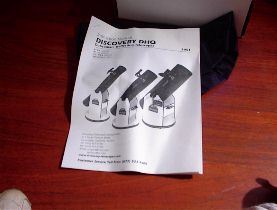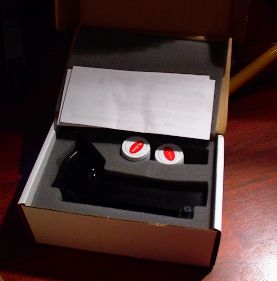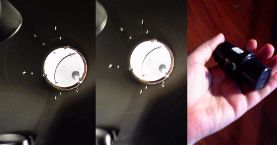|
Discovery 10" DHQ f/5.6 Dob
|
|
This is a quick summary of my experiences with my first Dobsonian telescope. Overall I'm happy. This page sums up my impressions so far. After a couple of weeks of research and shopping around, I decided the 10-inch f/5.6 Discovery DHQ Newtonian reflector (Dobsonian) was exactly what I wanted. I placed my order via phone on January 3 direct with the manufacturer, Discovery Telescopes in Oceanside CA. Tom took down my order and said that the scope would be ready in about two weeks. The telescope was $599 and freight was $69. The scope shipped January 18, only a day late, and Tom was able to obtain the UPS tracking numbers for me. Delivery took 3.5 business days from California to Oklahoma via UPS ground (counting MLK day as a half day). At some point during the weekend the UPS tracking system came up with a delivery date of January 21, but then reverted back to the original scheduled delivery date of January 24, which proved to be correct. I think the UPS tracking system is about as cryptic as airline fare structures. I'm happy to report there was no damage in transit, in spite of my nitpicking to follow. :^) Click any photo to enlarge |
 |
| The shipment came in three boxes. The tall one holds the tube, the small one contains the mirror and accessories, and the white one contains the mount pieces. |
 |
| Almost everything was nicely packaged, held in place by freshly-sprayed foam. I didn't like this box, however. The mount assembly was padded only from the top, leaving the mount hardware prone to being shattered if dropped. There was also no padding between the pieces. My friend Glenn used to work in the Dallas UPS hub and says that most people would be shocked if they had any idea how roughly packages are handled during unloading and sorting. Therefore I count on good packaging for anything coming through UPS. These pieces seem pretty sturdy and probably wouldn't break, but scraping together of the white surfaces could be troublesome. |
 |
| A minor drawback is that the manual was made up of faded photocopies, worn and wrinkled and stapled together. Here you see it right out of the box. As this is an $600 instrument, instructions should be clear and legible. Furthermore since this is an excellent telescope that will be with folks for decades, the manual should be designed to be a keepsake rather than something to keep hidden away. |
 |
| The Telrad I upgraded to, along with the standard 25 mm and 10 mm Plossl eyepieces come in this box. They're well packaged and have no chance of breaking. I haven't used the eyepieces thoroughly but they seem to be excellent. This box goes into the small padded carton shown in the first picture. |
 |
| For the most part, the tube is packaged securely, however it is a little vulnerable in the middle. |
 |
| This was one problem area: the box is too small for the tube, and the eyepiece mount presses directly against the box. For those who are receiving a telescope, this would be something to watch for at delivery time. The other problem area (see below) is along the altitude bearings, which make direct contact with the box. This makes the tube vulnerable to being crushed. Judging by the scrape mark it appears this box was subjected to a little pressure -- no big surprise. The rest of the tube is nicely packed and should resist most scuffs in transit. |
 |
 |
| The mirror is a nice piece of work. It's a beefy piece of aluminum-coated plate glass, and contains a factory-made center dot for collimation. |
 |
| The mirror measures 1.50" in thickness. |
 |
| One assembly issue was the 4-6 mm of loose space between the mirror mount arms and the bolt holes. Following the manual would result in all the bolts pulling the sonoboard tube inward. I doubt the stress is a good thing. Because of this I slipped an extra washer or two between the mount arms and the tube to "fill in" the space, then threaded the bolt through them. |
 |
| Sorry the picture is overexposed. This is the mount assembly, which needed some aesthetic work. First I removed the decals, which I thought were a bit cheesy. They came off easily without any residue. Then, BEFORE assembly, I taped over the Teflon contact pads and spray-painted all parts of the mount with a coat of Valspar gloss black enamel. Why did I do this? Simple -- it's night-vision friendly. I frequently find myself covering bright objects while observing, so the idea of having a bunch of white hardware outside kind of revolted me. Furthermore I think it makes the scope look much more handsome (matching our jet-black refrigerator!) My minor complaint with the mount is that Phillips screws hold the frame together. I really would have preferred Allen screws, as it's much easier on the wrist, less prone to stripping, and looks a little more attractive. |
 |
| This is a look down the tube. The secondary mirror is adjusted by two sets of agonist-antagonist adjustment screws. |
 |
| Telrad, focuser, and sample eyepiece on DHQ. |
 |
| The optional laser collimator that I got (discounted to me for $39) was defective. Even when snug in the eyepiece holder, turning the on/off thumbscrew causes a lot of travel of the laser dot, and turning it further past the on position results in it moving around on the primary by at least 2 inches or more! (See photo to view the position shift when the device is on, then turned off and turned on again) Rotating the collimator through 360° in the eyepiece holder traces out a 2-inch circle, also suggesting poor alignment of the collimator. I have read negative reviews on Yahoo Discovery Dobs and Usenet about this particular device and they seem to be substantiated in this case. There were no instructions packaged, however the device is labelled as manufactured by Discovery Telescopes in April 2001. |
 |
| The result? Very nice! The "shower cap" over the end is the storage protection cover. |
FIRST LIGHT. I spent about 30 minutes getting the scope collimated, using a traditional sight and Cheshire, then set the scope outside for an hour for mirror cooldown. Unbelievably, there wasn't the traditional overcast cloud deck to spoil things. However there were three problems: a bright moon, frigid 20°F temperatures, and saturated ground from the previous day's rains. The latter two combined to produce rapid frosting, which coated everything by the time we started observing and seemed to gum up the Telrad operation switch. Since winter nights here are usually a lot better, I decided to cut the observing session short and leave the hairdryer inside. Still, just goofing around here were my first impressions: I did find the azimuth movements somewhat tight, so I may have to use the classic Dobsonian trick of making washers out of 1-gallon milk jugs. I don't drink milk, though, so I guess I'll have to start telling my wife Shannon about the virtues of having plenty of calcium and vitamins in one's diet. :^) The improvements over our 3-inch Celestron are truly dramatic, even in spite of the fact we haven't been able to pull a sharp image on our first night. The scope is much more portable than I thought it would be. The 58" long tube can be carried easily through most door frames. The 32 lb tube and 27 lb mount are easily carried by most individuals, and setup is no more cumbersome than my Celestron with its retractable but awkwardly fixed tripod legs. We'll be keeping the Celestron, though, as it has a niche of its own (plus it's a go-to model).  Dawn the next morning -- 17°F and frost everywhere Warmer conditions are expected the following night, so the scope will get a good workout then.
|
Modifications and other projects: Fan modification! Similar pages: Return to main page |